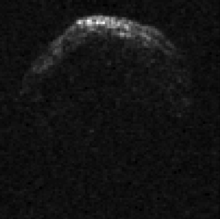(29075) 1950 DA
 | |
| 发现 [1] | |
|---|---|
| 发现地 | 利克天文台 |
| 发现日期 | 1950年2月23日 |
| 编号 | |
| 其它名称 | 1950 DA · 2000 YK66 |
| 小行星分类 | NEO · 阿波罗 · PHA [1][2] |
| 轨道参数 [2] | |
| 历元 2012年1月31日(JD 2455957.5) | |
| 不确定参数 0 | |
| 观测弧 | 67.96 yr (24,823 d) |
| 远日点 | 2.5619 AU |
| 近日点 | 0.8350 AU |
| 半长轴 | 1.6985 AU |
| 离心率 | 0.5083 |
| 轨道周期 | 2.21 yr (809 d) |
| 平近点角 | 315.94° |
| 轨道倾角 | 12.175° |
| 升交点黄经 | 356.74° |
| 近日点参数 | 224.61° |
| 与地球最小轨道相交距离 | 0.0406 AU (15.8169 LD) |
| 本征轨道参数 [3] | |
| 近日点岁差 | 13.655 弧秒 / 年 |
| 升交点黄经岁差 | −35.824 弧秒 / 年 |
| 物理特征 | |
| 质量 | >4×1012 kg[a] |
| 平均密度 | >3.5 g/cm3[4] |
| 自转周期 | 2.12160±0.00004 h[4] |
| 几何反照率 | 0.070[5] 0.25[6] |
| 光谱类型 | S [7][8] EM [9] B–V = 0.862±0.077[7] V–R = 0.494±0.069[7] V–I = 0.816±0.067[7] |
| 绝对星等(H) | 17.00[5] 17.1[1][2] 17.55±0.3 (R)[9][8] 18.0[8][4] |
(29075) 1950 DA的临时名称是1950 DA,归类为近地天体和有潜在威胁小行星,是直径大约1.1千米(0.68英里)的阿波罗小行星[4]。它曾经是撞击地球几率最高的天体之一[10]。在2002年,它有最高数值0.17的巴勒莫评级,可能在2880年与地球发生碰撞[11]。自那时以来,估计的风险已经多次更改。在2015年12月,撞击地球的几率修正为1/8,300(0.012%),巴勒莫评级为-1.42[10]。自2018年起,它列在哨兵系统上具有最高累积的巴勒莫评级[12]。因为2880年在未来的100年之后,1950 DA未列入杜林危险指数。
发现和命名
1950 DA由卡尔·维尔塔宁于1950年2月23日在利克天文台首次观测到[2]。它被观测了17天[13],之后就因为观测时间不足,使维尔塔计算的轨道解有着极大的不确定性而失踪了。在2000年12月31日,它重新被罗威尔天文台发现,并在2001年1月4日编号为2000 YK66[14]。但2小时后就确认是1950 DA[13][15]。
观测
在2001年3月5日,1950 DA接近地球至0.0520726 AU(7,789,950 km;4,840,450 mi)的距离[16]。阿雷西博和金石天文台从3月3日至7日都使用雷达研究它[13]。
研究表明这颗小行星的直径为1.1公里,并架设这是一颗逆向旋转[17]。由伦卡·萨鲁诺娃和彼得·普拉韦奇以光学分析光变曲线表明它的自转周期为2.1216±0.0001小时。由于它的自转周期短和雷达的高反射率,1950 DA被认为有相当高的密度(超过3.5 g/cm³,假设没有内部的张力),并且可能由铁、镍组成[4]。在2014年8月,田纳西大学的科学家确定"1950 DA"是由凡得瓦力凝聚在一起的碎石堆[18]。
撞击地球的可能性
1950 DA具有最佳测定的小行星轨道,其原因是[13]:
- 轨道相对于黄道有适度的倾角(12度)[2],减少了在轨道面上的摄动;
- 高精度的雷达天体测量,提供了距离和对可见光的波长测量的角度位置提供了补充;
- 有68年的观测弧[2];
- 不确定的区域受到共振的控制[13]。
主带小行星(78) 戴安娜(直径〜125公里)在2015年8月5日从距离1950 DA大约0.003 AU(450,000 km;280,000 mi)处掠过[13]。以这样的距离和大小,戴安娜对它轨道的扰动,足以使2880年(730年后)的轨道路径受到显著的影响。此外,在这段期间的亚尔科夫斯基效应也将导致1950 DA的旋转,使它的轨道略有变化。如果1950 DA继续在它当前的轨道上运行,可能在2880年3月16日接近地球时,将会在距离地球数百万公里处掠过。因此,1950 DA撞击地球的机会很低。在2015年12月7日得出的轨道解,显示在2880年撞击地球的几率只有8,300分之一(0.012%)[10]。
像1950 DA这样大小天体撞击释放出的能量将对气候和生物圈造成重大的影响,也将对人类文明造成破坏性的影响。潜在撞击的发现提高了人们对避免小行星撞击的兴趣。
相关条目
注解
- ^ 一份报告体积是1.14 km³ *,密度是3.5 g/cm³,估计质量(m=d*v)是3.99×1012 kg
参考资料
- ^ 1.0 1.1 1.2 29075 (1950 DA). Minor Planet Center. [2018-07-05]. (原始内容存档于2017-02-02).
- ^ 2.0 2.1 2.2 2.3 2.4 2.5 JPL Small-Body Database Browser: 29075 (1950 DA) (2018-02-09 last obs.). Jet Propulsion Laboratory. [2018-07-05]. (原始内容存档于2021-01-29).
- ^ (29075) 1950DA NeoDys – Proper Elements. [2018-03-11]. (原始内容存档于2018-03-12).
- ^ 4.0 4.1 4.2 4.3 4.4 Busch, Michael W.; Giorgini, Jon D.; Ostro, Steven J.; Benner, Lance A. M.; Jurgens, Raymond F.; Rose, Randy; et al. Physical modeling of near-Earth Asteroid (29075) 1950 DA (PDF). Icarus. October 2007, 190 (2): 608–621 [2018-07-05]. Bibcode:2007Icar..190..608B. doi:10.1016/j.icarus.2007.03.032. (原始内容存档 (PDF)于2020-10-03).
- ^ 5.0 5.1 Mainzer, A. K.; Bauer, J. M.; Cutri, R. M.; Grav, T.; Kramer, E. A.; Masiero, J. R.; et al. NEOWISE Diameters and Albedos V1.0. NASA Planetary Data System. June 2016 [2018-07-05]. Bibcode:2016PDSS..247.....M. (原始内容存档于2018-07-02).
- ^ Rivkin, A. S.; Binzel, R. P.; Bus, S. J. Constraining near-Earth object albedos using near-infrared spectroscopy. Icarus. May 2005, 175 (1): 175–180 [2018-07-05]. Bibcode:2005Icar..175..175R. doi:10.1016/j.icarus.2004.11.005.
- ^ 7.0 7.1 7.2 7.3 Dandy, C. L.; Fitzsimmons, A.; Collander-Brown, S. J. Optical colors of 56 near-Earth objects: trends with size and orbit. Icarus. June 2003, 163 (2): 363–373 [2018-07-05]. Bibcode:2003Icar..163..363D. doi:10.1016/S0019-1035(03)00087-3.
- ^ 8.0 8.1 8.2 LCDB Data for (29075). Asteroid Lightcurve Database (LCDB). [2018-07-05]. (原始内容存档于2020-03-09).
- ^ 9.0 9.1 NeoDys Near Earth Objects Dynamic Site (Physical Info). [2018-03-11]. (原始内容存档于2018-07-05).
- ^ 10.0 10.1 10.2 29075 (1950 DA) Earth Impact Risk Summary. NASA/JPL Near-Earth Object Program Office. 2015-12-07 [2018-03-11]. (原始内容存档于2013-05-11).
- ^ Asteroid 1950 DA. NASA/JPL Near-Earth Object Program Office. [2011-10-14]. (原始内容存档于2011-07-21).
- ^ Sentry Risk Table. NASA/JPL Near-Earth Object Program Office. [2018-03-20]. (原始内容存档于2014-12-31). (Use Unconstrained Settings)
- ^ 13.0 13.1 13.2 13.3 13.4 13.5 Giorgini, J. D.; Ostro, S. J.; Benner, L. A. M.; Chodas, P. W.; Chesley, S. R.; Hudson, R. S.; et al. Asteroid 1950 DA's Encounter with Earth in 2880: Physical Limits of Collision Probability Prediction (PDF). Science. April 2002, 296 (5565): 132–136 [2018-07-05]. Bibcode:2002Sci...296..132G. PMID 11935024. doi:10.1126/science.1068191. (原始内容 (PDF)存档于2017-02-09).
- ^ MPEC 2001-A22 : 2000 YK66. Minor Planet Center. 2001-01-04 [2018-02-23].
- ^ MPEC 2001-A26 : 1950 DA = 2000 YK66. Minor Planet Center. 2001-01-04 [2018-02-23]. (原始内容存档于2014-08-11).
- ^ JPL Close-Approach Data: 29075 (1950 DA) (last observation: 2018-02-09; arc: 67.96 years). [2018-03-11]. (原始内容存档于2013-02-13).
- ^ Farnocchia, D.; Chesley, S. R. Assessment of the 2880 impact threat from Asteroid (29075) 1950 DA (PDF). Icarus. February 2014, 229: 321–327 [2018-07-05]. Bibcode:2014Icar..229..321F. arXiv:1310.0861
 . doi:10.1016/j.icarus.2013.09.022. (原始内容存档 (PDF)于2018-07-05).
. doi:10.1016/j.icarus.2013.09.022. (原始内容存档 (PDF)于2018-07-05).
- ^ UT Research uncovers forces that hold asteroid together. U of Tennessee. [2015-08-17]. (原始内容存档于2017-04-09).
外部链接
- MPEC 2001-A26 : 1950 DA = 2000 YK66 (页面存档备份,存于互联网档案馆) (K00Y66K). MPC 4 January 2001
- 3D model (页面存档备份,存于互联网档案馆) Rotating model of the asteroid (preferred rotation model is retrograde, NeoDys (页面存档备份,存于互联网档案馆))
- Asteroid Lightcurve Database (LCDB) (页面存档备份,存于互联网档案馆), query form (info (页面存档备份,存于互联网档案馆))
- Asteroids and comets rotation curves, CdR (页面存档备份,存于互联网档案馆) – Observatoire de Genève, Raoul Behrend
- Discovery Circumstances: Numbered Minor Planets (25001)-(30000) (页面存档备份,存于互联网档案馆) – Minor Planet Center
- 小行星29075 at NeoDyS-2, Near Earth Objects—Dynamic Site
- Ephemeris · Obs prediction · Orbital info · MOID · Proper elements · Obs info · Physical info · NEOCC
- NASA JPL小天体数据库浏览器上的小行星29075
| 前一小行星: (29074) 5160 T-3 |
小行星列表 | 后一小行星: (29076) 1972 TR8 |
| |||||||||||||||||||||||||||||||||||||
Text is available under the CC BY-SA 4.0 license; additional terms may apply.
Images, videos and audio are available under their respective licenses.


